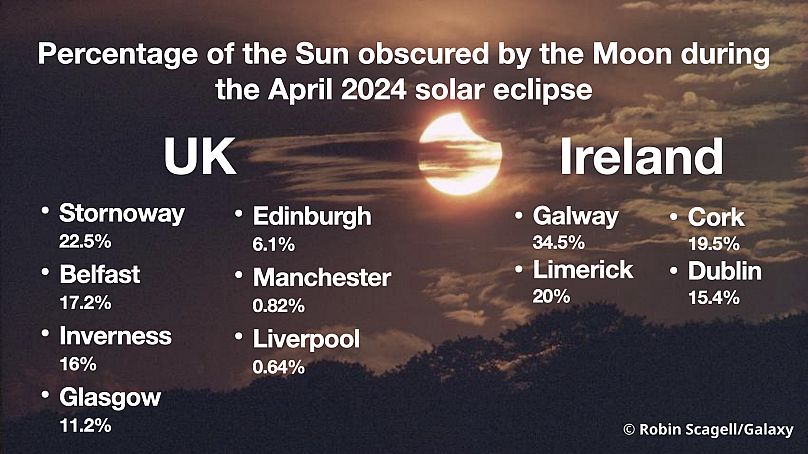While the path of totality of the eclipse on Monday will be in a narrow corridor across North America, some Europeans will catch a partial glimpse.
Parts of North America will be cast into darkness when a total solar eclipse occurs on Monday.
Weather permitting, tens of millions who live along a narrow stretch from Mexico's Pacific coast to eastern Canada can look skyward to glimpse day turn to twilight when the Moon blots out the Sun.
For those of us who live in Europe, you will not see a full eclipse this time or another one like until 2026. However, for people living in Ireland or the UK, a partial eclipse may be visible on Monday evening if the weather stays clear.
For those in North America lucky enough to be on its path of totality, eclipse glasses are a must to prevent eye damage. The only time it's safe to ditch protective glasses is during totality, or the few minutes of complete darkness.
If you're nowhere near its path of totality, clouds spoil your view or you live elsewhere in the world, you can still catch the total solar eclipse online.
Here are some alternatives if you're clouded out during the eclipse or if you can't travel to the path.
Partial eclipse in Ireland and the UK
There's no reason for the Mexicans, Americans, and Canadians to have all the fun.
If you live in either Ireland or the UK and want to experience this year's eclipse, don't lose hope. You may still experience a partial solar eclipse right before sunset in parts of the two countries on Monday.
The eclipse will be visible for longer, the further west you travel, with the west coast of Ireland expected to get the longest view.
Those living in and near the cities of Cork, Limerick, Galway, and Dublin in Ireland, and Belfast, Manchester, Liverpool, Inverness Glasgow, and Edinburgh in the UK, will likely get some visibility from higher ground and with clear skies.
For Europeans, the partial eclipse is expected to start at 8.52 pm CET and end at 9.51 pm CET.
NASA will be live from different eclipse cities
NASA is offering several hours of livestreaming online and on NASA TV starting at 1 pm EDT (7 pm CET) from several cities along the totality path.
The space agency will show telescope views of the sun and there will be appearances by scientists and space station astronauts.
During the eclipse, small rockets will blast off from Wallops Island, Virginia, with science instruments into the electrically charged portion of the atmosphere near the edge of space known as the ionosphere.
Telescopes and experiments focus on the Sun
The Exploratorium museum will feature live telescope images of the sun from Junction, Texas, and Torreón, Mexico.
Researchers and students from the University of Maine will launch high-altitude balloons in an experiment that will be livestreamed from the stratosphere.












